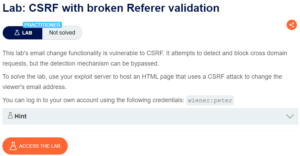CSRF with broken Referer validation

Descripción This lab’s email change functionality is vulnerable to CSRF. It attempts to detect and block cross domain requests, but the detection mechanism can be bypassed. To solve the lab, use your exploit server to host an HTML page that uses a CSRF attack to change the viewer’s email address. You can log in to […]